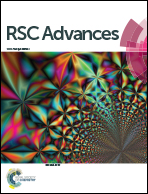Photodynamic therapy of drug-resistant human colon adenocarcinoma using verteporfin-loaded TPGS nanoparticles with tumor homing and penetrating peptide functionalization†
Abstract
Photodynamic therapy (PDT) does well in both curing early stage tumors and improving patients’ quality of life. However, the limited selectivity of photosensitizers (PSs) to tumors has become an urgent issue during the application of PDT clinically, which would exhibit a poor therapeutic outcome and induce skin phototoxicity. To solve this problem, PS-loaded D-α-tocopheryl polyethylene glycol succinate (vitamin E TPGS, or simply TPGS) nanoparticles with tumor homing and penetrating peptide tLyp-1 decoration (t-NP) were constructed for PDT of tumors in this study. Verteporfin (VP), as an effective PS, was encapsulated in the core of t-NP, and tLyp-1 was functionalized on the surface as a functional ligand to increase vascular permeability and target the tumor cells. These nanoparticles were spherical in shape and exhibited a narrow size distribution of 23.3 ± 0.80 nm, and had a high encapsulation efficiency and loading capacity of hydrophobic VP. Compared with unmodified nanoparticles (NP), t-NP exhibited enhanced cellular uptake in both primary human umbilical vein endothelial cells (HUVECs) and drug-resistant human colon adenocarcinoma cells (HCT15); and t-NP showed higher selectivity to HCT15 tumors in vivo after intravenous administration of the same dose of VP. The anti-tumor experiment in vivo strongly indicated that nanoparticles with tLyp-1 peptide modification can enhance the selectivity of the PS, and improve the PDT effect.


 Please wait while we load your content...
Please wait while we load your content...